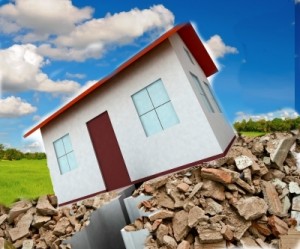Even though there may be a relatively low probability of ever needing it, home insurance is a necessary part of owning a home and you will certainly be glad you have it if you ever do need it. Whether you have an upscale mansion or a small apartment, insurance is a way to protect your assets and your financial investment. Unfortunately, insurance can vary significantly in price and coverage depending on where in the world you happen to live.
 In environmentally unstable regions, such as parts of California where fires, earthquakes or mudslides are common, getting insurance may end up being a long, frustrating and expensive process. Believe it or not, according to the Insurance Information Institute just under one percent of the American population lives in a location that is deemed uninsurable. Here are some things that potential homeowners should know about getting insurance in high risk areas, and also some key pointers for determining what areas could be classified as environmentally unsound.
In environmentally unstable regions, such as parts of California where fires, earthquakes or mudslides are common, getting insurance may end up being a long, frustrating and expensive process. Believe it or not, according to the Insurance Information Institute just under one percent of the American population lives in a location that is deemed uninsurable. Here are some things that potential homeowners should know about getting insurance in high risk areas, and also some key pointers for determining what areas could be classified as environmentally unsound.
What is an Environmentally Unsound Region?
There are many places around the United States that are considered to be environmentally unsound. Regardless of the type of home built or the security measures taken to prevent disaster, any properties located in these areas will be labeled as high risk and may not be covered under many types of home insurance even though insurance is necessary in order to obtain a Mortgage .
These areas are as diverse as parts of Tornado Alley in the Midwestern United States, areas along Florida’s coast that are prone to hurricanes and regions of California where brush fires and earthquakes are incredibly common are all considered to be environmentally unsound by insurance providers. Often these areas are considered highly desirable “prime” real estate with fantastic views overlooking the ocean And although individuals can live and build homes in these areas, it is important to note that getting insurance won’t always be easy, and in some cases it might even prove to be nearly impossible.
Repeat Claims Putting Homeowners Under a High-Risk Classification
Even homeowners who don’t technically live in environmentally unsound regions can still have their individual homes classified as having high-risk properties, which can cause them to pay much higher fees than normal or even have their claims denied. One of the most common causes for the label of high-risk property is multiple claims within a year. For example, someone who lives in a floodplain and files two claims within the calendar year because of flooding may eventually be denied coverage due to their high risks. This can be traumatic, and not having adequate coverage in a dangerous area puts the homeowners and their families at financial risk and may even make it impossible to sell the house because the next owner’s mortgage company requires homeowner’s insurance before they will make the loan.
Consider a State Fair Plan
In those areas where obtaining private insurance for the home can be astronomical due to environmental instability, there are often ways to pay less. Anyone who is denied coverage by two or more companies, for example, can apply to be part of their state’s Fair Plan. Fair Plan is essentially a hisk-risk insurance pool, which combines all participant policies in order to lower rates across the board.
Although Fair Plan coverage may be more expensive than coverage of a low-risk home, it is still much cheaper than seeking out traditional coverage on a high-risk home. The following states offer Fair Plan coverage as an option for residents. In addition, a few states (namely Florida and Louisana), have a counterpart to FAIR plans called Beach and Windstorm coverage for hurricanes and severe windstorms.
|
State
|
FAIR plan phone number
|
|
|
Alabama
|
(334) 943-4029
|
|
|
California
|
(213) 487-0111
|
|
|
Connecticut
|
(860) 528-9546
|
|
|
Delaware
|
(215) 629-8800
|
|
|
District of Columbia
|
(202) 393-4640
|
|
|
Florida Joint Underwriting Association
|
(850) 513-3700
|
|
|
Florida Windstorm Underwriting Association
|
(904) 296-6105
|
|
|
Georgia
|
(770) 923-7431
|
|
|
Hawaii
|
(808) 531-1311
|
|
|
Illinois
|
(312) 861-0385
|
|
|
Indiana
|
(317) 264-2310
|
|
|
Iowa
|
(515) 255-9531
|
|
|
Kansas
|
(785) 271-2300
|
|
|
Kentucky
|
(502) 425-9998
|
|
|
Louisiana FAIR Plan
|
(504) 831-6930
|
|
|
Louisiana Beach Plan
|
(504) 831-6930
|
|
|
Maryland
|
(410) 539-6808
|
|
|
Massachusetts
|
(617) 723-3800
|
|
|
Michigan
|
(313) 877-7400
|
|
|
Minnesota
|
(612) 338-7584
|
|
|
Mississippi
|
(601) 981-2915
|
|
|
Missouri
|
(314) 421-0170
|
|
|
New Jersey
|
(973) 622-3838
|
|
|
New Mexico
|
(505) 878-9563
|
|
|
New York
|
(212) 208-9700
|
|
|
Ohio
|
(614) 839-6446
|
|
|
Oregon
|
(503) 643-5448
|
|
|
Pennsylvania
|
(215) 629-8800
|
|
|
Rhode Island
|
(617) 723-3800
|
|
|
South Carolina
|
(803) 737-6180
|
|
|
Texas
|
(512) 899-4900
|
|
|
Virginia
|
(804) 358-0416
|
|
|
Washington
|
(425) 745-9808
|
|
|
West Virginia
|
(215) 629-8800
|
|
|
Wisconsin
|
(414) 291-5353
|
|
|
Source: Insurance Information Institute (III)
|
||
Paying Less For Coverage in Environmentally Unstable Regions
Thankfully, there are some ways that homeowners can reduce their coverage costs. Raising the deductible is the simplest way to lower monthly costs by as much as one-third. The most important step is to shop around, as high-risk insurance providers can offer drastically different policy prices across the board.
Although home insurance can be incredibly expensive in areas where tornadoes, storms or hurricanes are common, coverage is still a vital part of home ownership for any individual.
See Also:
- Flood Coverage Isn’t Included in the Standard Homeowner’s Insurance
- Mortgage Jargon
- 5 Good Reasons To Get Title Insurance
- Financial Jargon – Investment Terminology for Beginners
- More about Mortgages
Recommended by Amazon:
- Insurance for Dummies
- The Complete Dictionary of Insurance Terms Explained Simply
- The AIG Story
- Be Insurance Savvy: Home, Auto, Dwelling, Renter’s, Flood and other Personal Insurance Explained
- Health Insurance: Navigating Traps & Gaps
About the Author:
Brandon Smith is a freelancer who writes on finance, investment, personal savings, banking, real estate, insurance, and other related matters; to learn more about home insurance view the resources available at Kanetix.
Image courtesy of Stuart Miles / FreeDigitalPhotos.net


